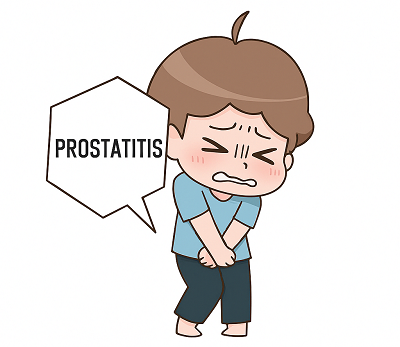Recurrent Chronic Non-Bacterial Prostatitis: How to Diagnose and Treat It?
Chronic prostatitis is the most common type among various types of prostatitis, and it is also a common and puzzling disease in the department of urology. Because it not only accounts for a relatively large proportion but is also prone to recurrence. According to statistics, the recurrence rate of chronic prostatitis is 25% - 50%.

Chronic prostatitis can be further divided into chronic bacterial prostatitis and chronic non-bacterial prostatitis, among which the latter accounts for about 90% of chronic prostatitis.
Therefore, in this issue, let's take a detailed look at the causes, diagnosis, and standardized treatment of chronic non-bacterial prostatitis.
Causes of Chronic Non-bacterial Prostatitis
The pathogenesis of chronic non-bacterial prostatitis remains unclear, and its etiology is extremely complex. Most scholars believe that its main causes may be the combined effects of pathogen infection, inflammation, abnormal pelvic floor neuromuscular activities, and abnormal immunity, psychology, and neuroendocrine systems.
The specific causes are as follows:
Pathogen Infection: Although pathogens cannot be isolated in routine examinations for this symptom, it may still be related to certain special pathogens, such as anaerobic bacteria and mycoplasma infections. Some "sterile" prostatitis cases clinically, which are mainly characterized by chronic inflammation and tend to recur or worsen, may be associated with these pathogens.
Urination Dysfunction: Certain factors can cause the contraction of the urethral sphincter, leading to bladder outlet obstruction and the formation of residual urine. This causes urine to flow backward into the prostate. Not only can it bring pathogens into the prostate, but it can also directly stimulate the prostate, inducing sterile "chemical prostatitis."
Psychological Factors: Psychological factors such as anxiety, depression, and hypochondriasis can cause autonomic nerve dysfunction. This leads to the disorder of the neuromuscular function of the posterior urethra, resulting in pelvic region pain and urination dysfunction, and inducing chronic non-bacterial prostatitis.
Neuroendocrine Factors: Patients with prostatodynia often experience fluctuations in heart rate and blood pressure, indicating that it may be related to the autonomic nerve response. Their pain has the characteristics of visceral organs.
Abnormal Immune Response: In recent years, research has shown that immune factors play an important role in the occurrence, development, and course evolution of chronic non-bacterial prostatitis. Certain changes in the levels of cytokines, such as IL6 and IL10, can be found in the patient's prostatic fluid, seminal plasma, and tissue blood. Moreover, the level of IL10 is positively correlated with the pain symptoms of patients with chronic non-bacterial prostatitis, and the application of immunosuppressants has a certain effect.
Pelvic-related Disease Factors: Some prostatitis patients are often accompanied by the dilation of the venous plexus in the peripheral zone of the prostate and varicocele of the spermatic cord. This suggests that the symptoms of some patients with chronic prostatitis may be related to pelvic venous congestion and blood stasis.
Lower Urinary Tract Epithelial Dysfunction: It is caused by the disruption of the balance between the potential protective factors and damaging factors of the lower urinary tract epithelium. The damaging factors include potassium ions and antiproliferative factors in the urine.
Clinical Manifestations, Diagnosis, and Identification
Clinical Manifestations:
The clinical manifestations of chronic non-bacterial prostatitis are similar to those of chronic bacterial prostatitis.
It is mainly manifested as abnormal urination (frequent urination, urgent urination, urinary hesitancy, and dribbling) and local pain (dull pain and discomfort in the perineum, lower abdomen, penis, and scrotum).
However, chronic non-bacterial prostatitis does not have repeated urinary tract infection episodes and the common phenomenon of prostatic fluid overflowing from the urethra.
Diagnosis and Identification
It has clinical symptoms such as abnormal urination and local pain. During rectal digital examination, the prostate is relatively full, slightly soft in texture, and has mild tenderness.
The prostatic massage fluid can be easily discharged after massage. The prostatic fluid is thin and not turbid. When examined, the white blood cell count is > 10 per high-power field, or there are only a small number of white blood cells or no white blood cells at all.
This symptom is mainly differentiated from chronic bacterial prostatitis, and the main difference lies in the presence or absence of a urinary tract infection. In fact, all patients with chronic bacterial prostatitis have a urinary tract infection, such as cystitis.
While patients with chronic non-bacterial prostatitis do not have a urinary tract infection.
Four Treatment Methods
The clinical progress of chronic non-bacterial prostatitis is not clear, and it is not sufficient to threaten the patient's life and the function of important organs. Not all patients need treatment. The main goals of treatment are to relieve pain and improve urination symptoms, which can be divided into general treatment, drug treatment, other treatments, and traditional Chinese medicine treatment.
General Treatment
Health education, psychological, and behavioral counseling play a positive role. Patients should quit drinking and avoid spicy and irritating foods. Avoid holding urine, sitting for long periods, pay attention to keeping warm, and strengthen physical exercise and regular sexual life, which are helpful for improving the symptoms of patients with prostatitis.
Drug Treatment
The most commonly used drugs are antibiotics, α-blockers, plant preparations, and non-steroidal anti-inflammatory drugs. There are also antidepressants and anxiolytics, which have varying degrees of curative effects in relieving symptoms.
Antibiotics: Antibiotic treatment is mostly empirical treatment. It is recommended to take oral antibiotics such as quinolones for 2 to 4 weeks first, and then decide whether to continue using antibiotics according to the feedback of the curative effect. It is only recommended to continue using them when the patient's clinical symptoms are indeed alleviated, and the recommended total treatment course is 4 to 6 weeks.
α-blockers: They can improve lower urinary tract symptoms and pain by relaxing the smooth muscles of the prostate and bladder neck. The drugs that can be used include doxazosin, tamsulosin, terazosin, silodosin, etc.
Plant Preparations: Plant preparations mainly refer to pollen preparations and plant extracts. Their pharmacological effects are relatively extensive, including non-specific anti-inflammation, anti-edema, and promoting the relaxation of the urethral smooth muscle.
Non-steroidal Anti-inflammatory Drugs: They are also empirical drugs, and their main purpose is to relieve pain and discomfort.
Antidepressant and Anxiolytic Drugs: For patients with comorbid mood disorders such as depression and anxiety, while treating prostatitis, antidepressant and anxiolytic drugs can be used. They can not only improve the patient's mood disorder symptoms but also relieve physical symptoms such as abnormal urination and pain.
Other Treatment Methods
Other treatment methods include transperineal extracorporeal shock wave therapy, prostate perfusion therapy, psychological treatment, surgical treatment, etc.
Traditional Chinese Medicine Treatment
Chronic prostatitis belongs to the category of "jingzhuo" (essence turbidity) and "baizhuo" (white turbidity) in traditional Chinese medicine. Long-term clinical practice has proved that the combination of traditional Chinese and Western medicine has obvious advantages in treating this symptom, such as the Diuretic Anti-inflammatory Pill.
In addition to traditional Chinese medicine, some adjuvant therapies can also be used: acupuncture, prostate massage, heat therapy, traditional Chinese medicine sitz bath, traditional Chinese medicine fumigation, traditional Chinese medicine application, etc., which can also achieve certain curative effects, but the indications and contraindications need to be mastered.
It Is Important to Keep a Good Mood
Chronic non-bacterial prostatitis is a complex and common disease. Clinical practice has shown that the treatment effect of patients with an optimistic attitude is much better than that of patients with a depressed attitude. Therefore, it is very important to maintain a good attitude during the treatment process.
Is masturbation a bad habit? It doesn't matter. As long as you feel comfortable. Do you think this doctor is not very good? It doesn't matter. Just change to another one. Even if you are diagnosed, you should still maintain a good attitude and actively receive treatment.
In short, don't be intimidated into being a "deserter" by chronic non-bacterial prostatitis.
You may also be interested in:
A Successful Case On Curing Non-bacterial Prostatitis By Diuretic and Anti-inflammatory Pill



